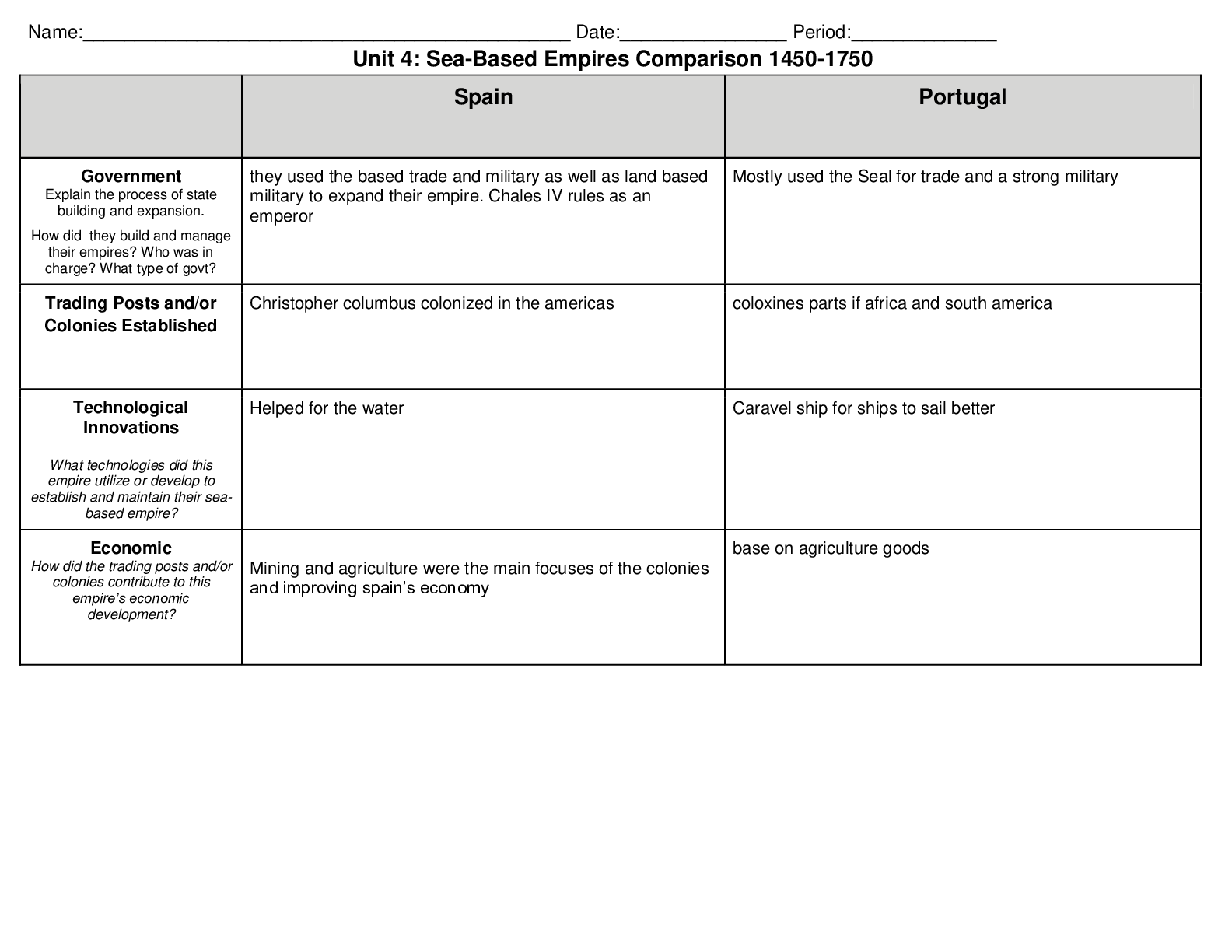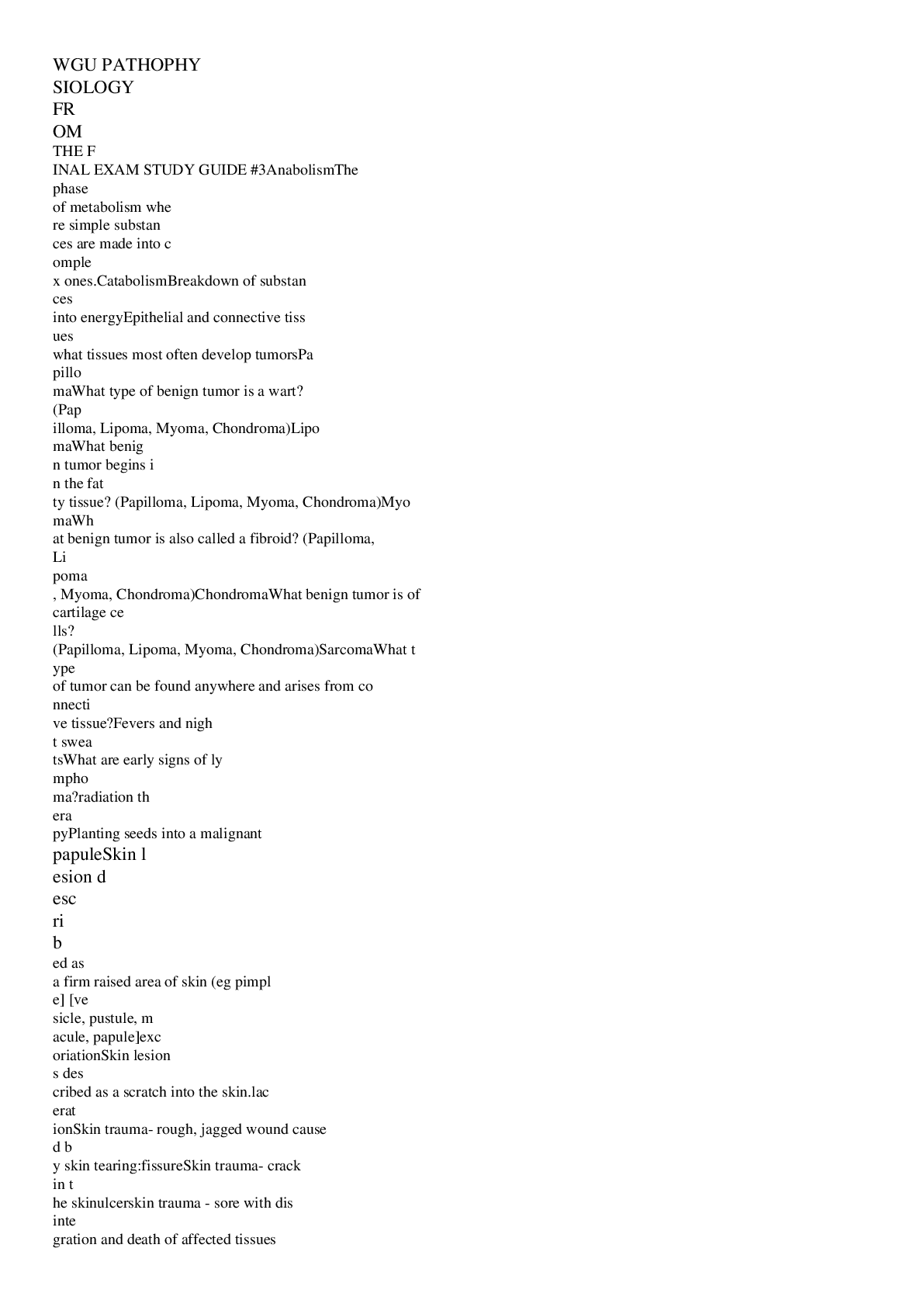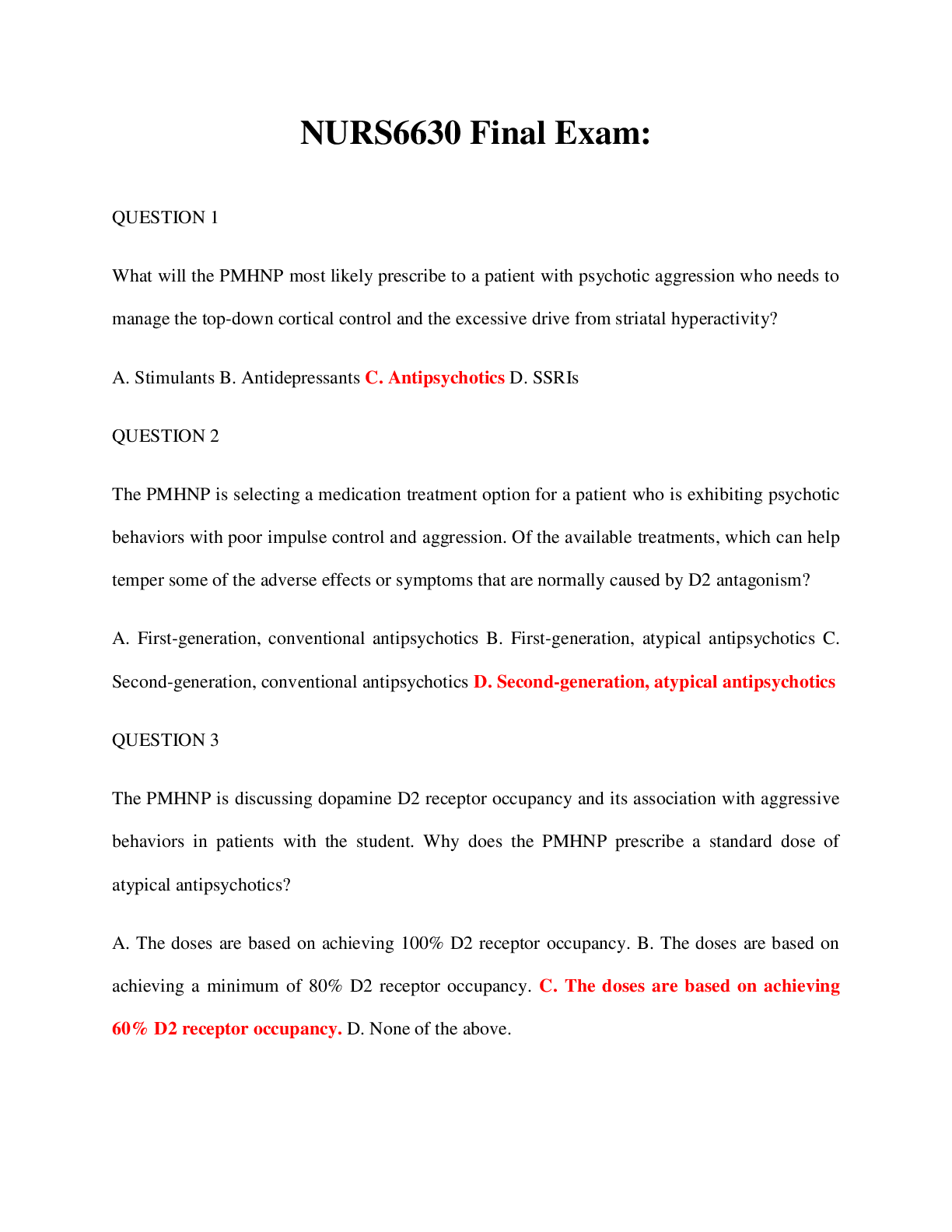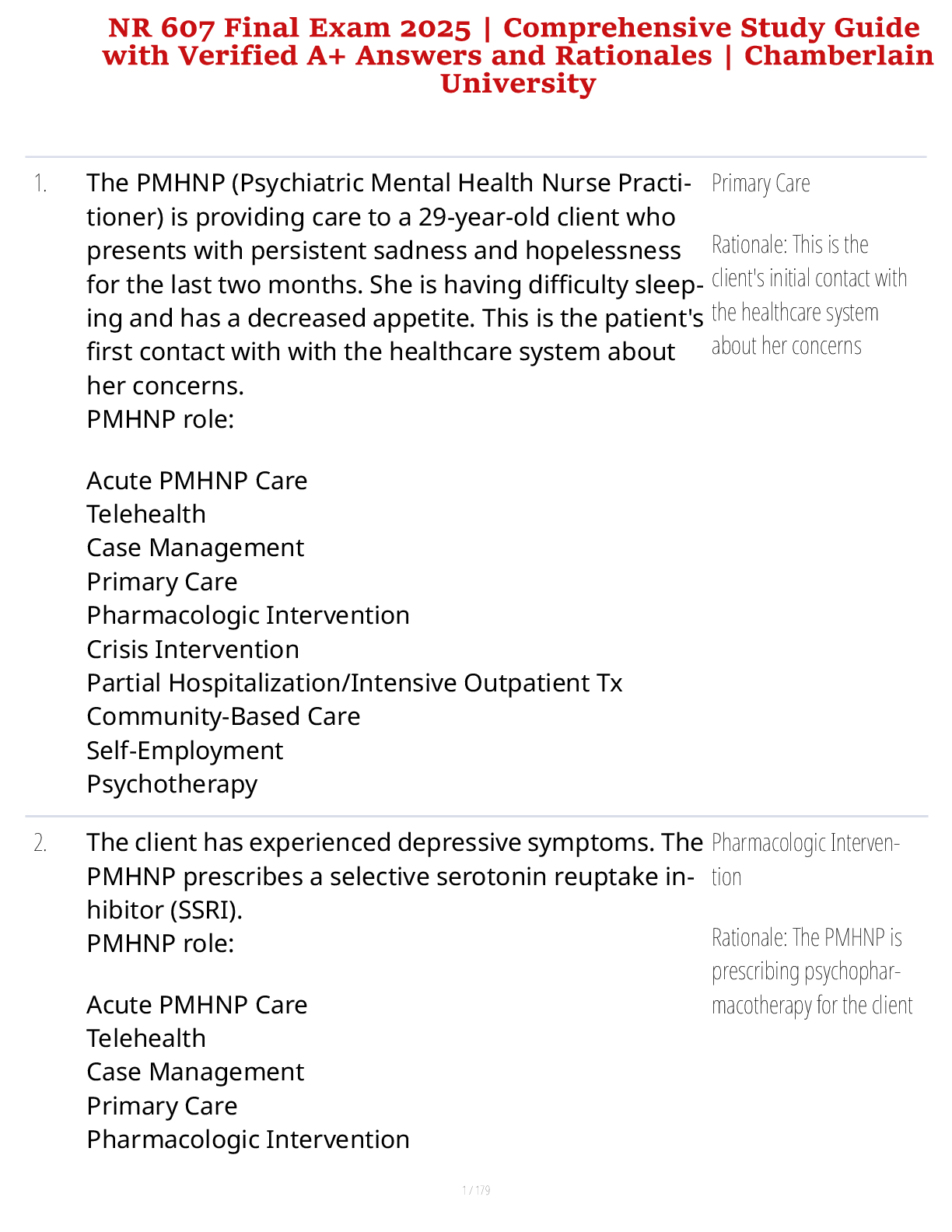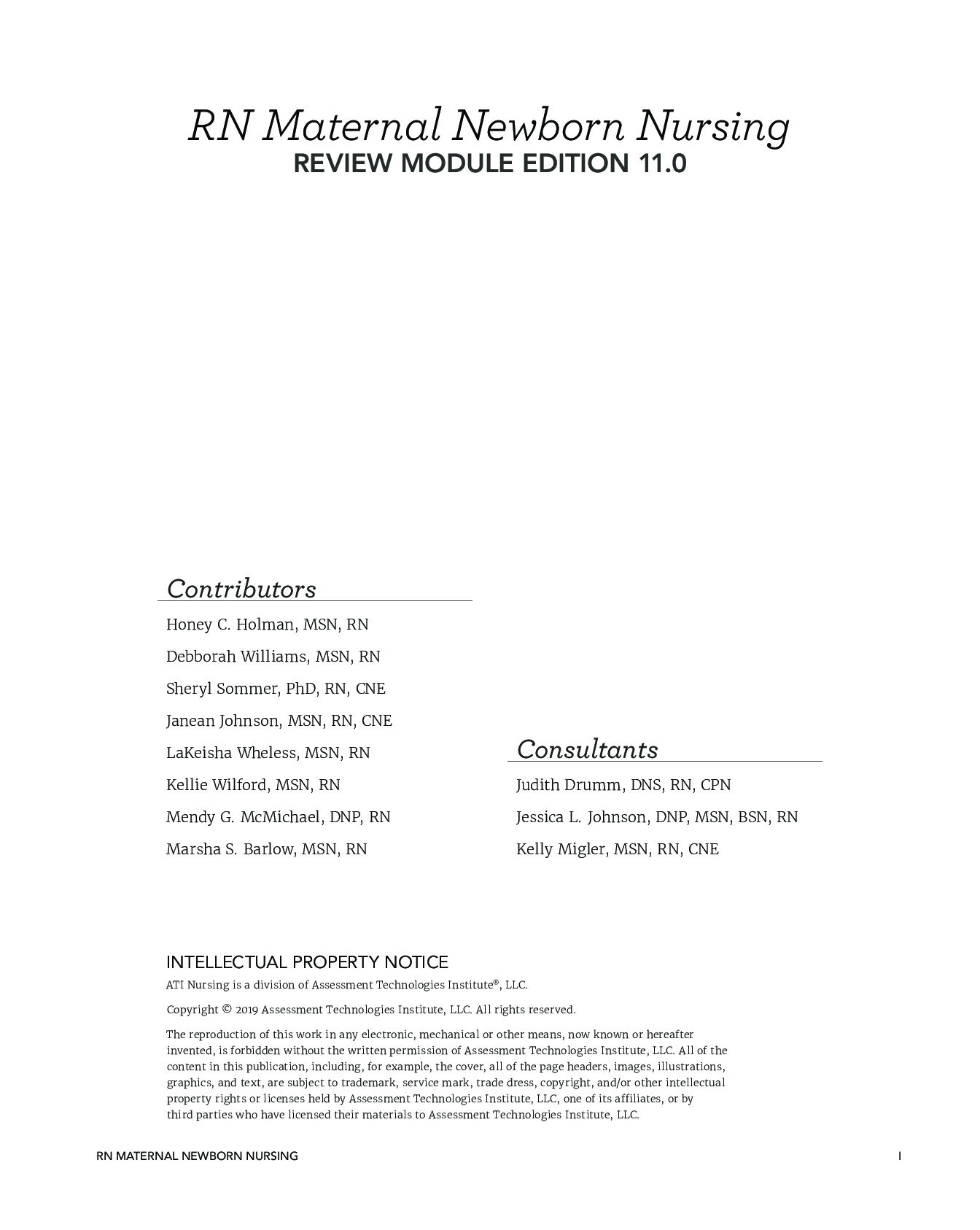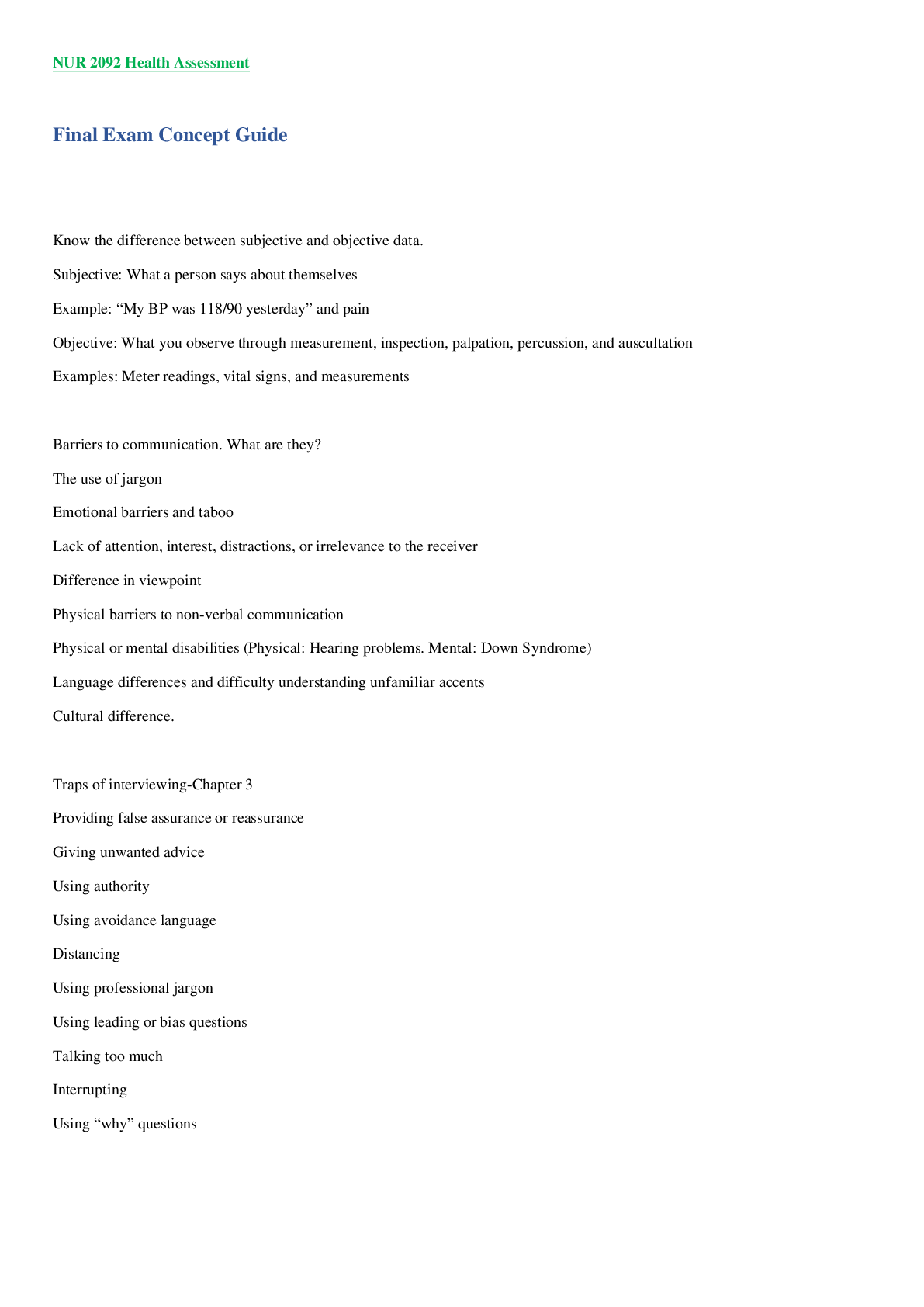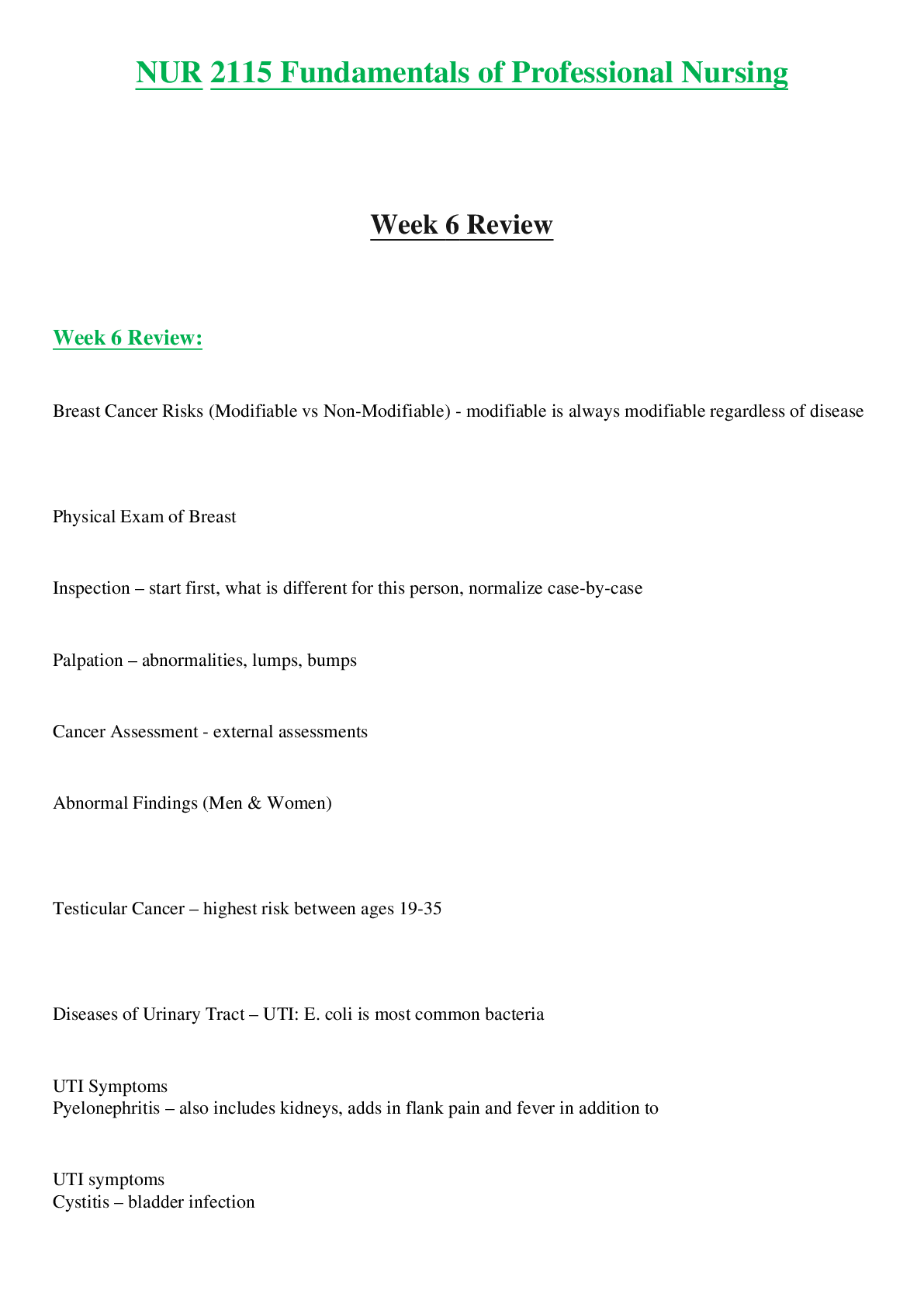History > STUDY GUIDE > HIEU 201 TEST 1 STUDY GUIDE TEST 1 STUDY GUIDE Completed A 2022/2023 (All)
HIEU 201 TEST 1 STUDY GUIDE TEST 1 STUDY GUIDE Completed A 2022/2023
Document Content and Description Below
HIEU 201 Page 1 of 15 HIEU 201 TEST_1_STUDY_GUIDE/TEST 1 STUDY GUIDE Before beginning the test, make sure that you have read the assigned chapters of the textbook and viewed the lectures with the ... reading (see Study Schedule). Once you have completed the reading, use the following list of key points as a study guide for the test. Do not attempt to take the test on the same day that you completed your reading – give at least 1 day for studying and reviewing the concepts. Textbook—Make sure to review the assigned chapters in the Module/Week 1 textbook readings. 1. Understand the importance of the Epic of Gilgamesh. Mesopotamian epic that depicts a mood of uncertainty and anxiety, an awareness of the cosmos as unfathomable and mysterious, a felling of dread about the fragility of human achievement (pessimism, despair) theme: the human protest against death Gilgamesh deals with the death of his close friend this forces him to face the reality of his own death. He realizes that he is afraid of death. Gilgamesh yearns for eternal life; but the gods allotted to humans only death. Only the gods live forever 2. Understand the reign of Hatshepsut of Egypt. From Wikipedia: 1478. Officially she ruled jointly. One of the most successful pharaohs. Reigning longer than anly other woman. Accomplishments: trade networks, prolific building projects, 3. Understand the role of pharaoh in Egyptian civilization.HIEU 201 Page 2 of 15 Pharaoh was both man and god; an earthly embodiement of the deity Horu. Absolute ruler who held his court in Memphis. Benevolent protector who controls the floodwaters, maintained justice, and expressed the will of heaven. When he died he joined his fellow gods and would still help. 4. Understand the significance of geography in Egyptian civilization. Developed in the fertile land of the Nile. The river flooded and left behind fertile black soil which created an abundant food supply. Provided fish, fow and transportation. Mountains, deserts, cataracts, and the Mediterranean protected Egypt. Gold, copper, and stone. The climate of Egypt is dry and salutary. 5. Understand the origins of the alphabet.Define and understand the term mythopoeic. Understand the central role of religion in ancient civilizations. Mythopoeic – mythmaking, a view of the world that gives near Eastern civilization its distinctive form and allows us to see it as an organic whole. Phonetic alphabet derived from the Near East. Religion - Religion dominated and inspired all features of Near Eastern society—law, kingship, art, and science. In the first civilizations, the deepest thoughts of human beings were expressed in the form of religious myths. They were the source of the vitality and creativity of Mesopotamian and Egyptian civilizations. Near Eastern art derived from religion, and science was permeated with it; literature and history dealt with the ways of the gods; and priest- kings or god- kings, their power sanctioned by divine forces, furnished the necessary authority to organize large numbers of people in cooperative ventures. Religion also encouraged and justified wars—including enslavements and massacres—which were seen as conflicts between the gods. Religious beliefs and values served as a powerful social force uniting people into a cohesive community. 6. Understand the key differences between Hebrews and Near Eastern neighborsHIEU 201 Page 3 of 15 Hebrews orginated in Mesopotamia then migrated to caanan. Had patriarchs lead them. Didn’t believe in pharaoh. Were once slaves to Egypt. Saul was the first King then David. Conquest Captivity resoration. God spcriptures. Covenant law. Valued historical relevalnce: kept calendars. Valued future. Social justice 7. Describe the Assyrian civilization. Carefully planned military, weapons, farmer-solider,building, roads, messenger service, terror and deportation to keep people in line, moved people around to control labor services, spread and maintain culture, Collapsed with the rise of the Chaldean empire 8. Describe the Persian civilization.Understand the history of the Israelites in Canaan. Cyrus the great led the Persians. In 25 years they conquered all of the land between the nile and indus river. Persian king became an absolute monarch. 20 provinces. Language: Aramaic. Provided impressive unity. 9. Understand the two captivities of the Israelites. Babylonian Captivity Assyrian captivity 10. Understand the place of women in Jewish law. Father controlled the house Women couldn’t get divorced Husband was considered wife’s master Respect for women: wise women and prophetesses, husband must love his wife, women = people not property, men cant hit women, 11. What are the Dead Sea Scrolls, and what is their significance for Biblical studies? God’s law, as recorded in the Holy Scriptures, still remains a unifying force among Jews. Many ancient Hebrew scrolls were found in caves near the west bank of the Dead Sea beginning in the late 1940s. TheHIEU 201 Page 4 of 15 scroll depicted here contains the earliest existing copy of a complete Hebrew text of the book of the prophet Isaiah. It barely differs from more modern manuscripts 12. What are the central themes of the Old Testament? Justice Sovereign God Individual / moral autonomy History—maybe Social Justice Universalism Individualism 13. What was the role of the prophets? Spiritually inspired individuals who felt compelled to be God’s messengers The prophets cared nothing for money or possessions, feared no one, and preached without invitation. Often emerging in times of social distress and moral confusion, the prophets pleaded for a return to the covenant and the Law. Speaking in God’s name, they exhorted the entire nation to make God’s religious- moral commands central to its existence. Believing that they had been dispatched by God to rescue the disobedient Hebrews from their headlong rush to destruction, the prophets reminded their brethren that because of their moral deterioration, God, who rules history, would inflict swift and terrible punishment on them. The prophets were remarkably courageous people who did not quake before the powerful. Among the prophets were Amos, a shepherd from Judea in the south; his younger contemporary, Hosea, from Israel in the north; Isaiah of Jerusalem; and Jeremiah, who witnessed the siege of Jerusalem by the Chaldeans in the early sixth century b.c. 14. Understand the legacy of each major civilization: Mesopotamian, Egyptian, Assyrian, Persian, HebrewHIEU 201 Page 5 of 15 Hebrews: THE LEGACY OF THE ANCIENT JEWS For the Jews, monotheism had initiated a process of self- discovery and self- realization unmatched by other peoples of the Near East. The great value that Westerners give to the individual and to human dignity derives in part from the ancient Hebrews, who held that man and woman were created in God’s image and possessed free will and a conscience answerable to God. Inherited by Christianity, the prophets’ teachings constitute the core principles of Western morality, and their command to the power structure not to abuse their authority but to pursue justice continues to inspire reformers. Throughout the centuries, the Jewish Bible, with its view of God, human nature, divine punishment, the pursuit of righteousness, and social justice, has played a pivotal and profound role in Jewish life. Moreover, its significance has transcended the Jewish experience; it is also a cornerstone of Western civilization. Christianity, the essential religion of Western civilization, emerged from ancient Judaism, and the links between the two, including monotheism, moral autonomy, prophetic values, and the Hebrew Mesopotamia: In succeeding centuries, the Sumerian cities were incorporated into various kingdoms and empires. The Sumerian language, which was replaced by a Semitic tongue, became an obscure language known only to priests, and the Sumerians gradually disappeared as a distinct people. But their cultural achievements endured. Akkadians, Babylonians, Elamites, and others adopted Sumerian religious, legal, literary, and art forms. The Sumerian legacy served as the basis for a Mesopotamian civilization that maintained a distinct style for three thousand years. Egypt: Sumerians and Egyptians demonstrated enormous creativity and intelligence. They built irrigation works and cities, organized governments, charted the course of heavenly bodies, performed mathematical operations, constructed large- scale monuments, engaged in international trade, established bureaucracies and schools, and considerably advanced the level of technology and engineering skills. Without the Sumerian invention of writing—one of the great creative acts in history—what we mean by civilization could not have emerged. Many elements of ancient Near Eastern civilization were passed onHIEU 201 Page 6 of 15 to the West. The wheeled vehicle, the plow, coinage, and the phonetic alphabet—all important to the development of civilization— derive from the Near East. In the realm of medicine, the Egyptians knew the value of certain drugs, such as castor oil; they also knew how to use splints and bandages. The innovative divisions that gave 360 degrees to a circle and 60 minutes to an hour originated in Mesopotamia. Egyptian geometry and Babylonian astronomy were utilized by the Greeks and became a part of Western knowledge. The belief that a king’s power came from a heavenly source, a key idea in historic Western political thought, also derived from the Near East. In Christian art, too, one finds connections to the Mesopotamian art forms—for example, the Assyrians depicted winged angel- like beings. Both the Hebrews and the Greeks borrowed Mesopotamian literary themes. For example, some biblical stories—the Flood, the quarrel between Cain and Abel, and the Tower of Babel— stem from Mesopotamian antecedents. A similar link exists between the Greek and the earlier Mesopotamian mythologies. Thus, many achievements of the Egyptians and the Mesopotamians were inherited and assimilated by both the Greeks and the Hebrews, the principal founders of Western civilization. Even more important for an understanding of the essential meaning of Western civilization are the ways in which the Greeks and Hebrews rejected or transformed elements of the older Near Eastern traditions to create new points of departure for the human mind. Assyrian: Despite an almost all- consuming concern for war, the Assyrians maintained and spread the culture of the past. They copied and edited the literary works of Babylonia, adopted the old Sumerian gods, and used Mesopotamian art forms. The Assyrian king Ashurbanipal (669–626 b.c.) maintained a great library, which contained thousands of clay tablets. ―The king knows that all lands hate us,‖ wrote an official to King Esarhaddon (680–669 b.c.).16 After a period of wars and revolts weakened Assyria, a coalition of Medes, or Indo- Europeans from Iran, and the Semitic Chaldeans, or NeoBabylonians, sacked the Assyrian capital of Nineveh in 612 b.c. The conquerors looted and destroyed the city, and the surviving Assyrians fled. Assyrian power was broken.HIEU 201 Page 7 of 15 Persian: The political and cultural universalism of the Persian empire had its counterpart in the emergence of an ethically oriented religion, Zoroastrianism. Named for its founder, the Persian prophet Zarathustra (Zoroaster in Greek), who probably lived in the sixth century b.c. (some scholars place him much earlier), this religion taught belief in Ahura Mazda—the Wise Lord— god of light, the embodiment of justice, wisdom, goodness, and immortality. In addition to the Wise Lord, there also existed Ahriman, the spirit of darkness, who was evil and destructive. Ahriman was in conflict with Ahura Mazda. People magic, polytheism, and blood sacrifices and instead stressed ethics. Persia unified the nations of the Near East into a world- state, headed by a divinely appointed king, and synthesized the region’s cultural traditions. Soon it would confront the city- states of Greece, whose political system and cultural orientation differed from that of the Near East. 15. Understand the legacy of small nations such as the Hittites In addition to the Sumerians and Egyptians, founders of the first civilizations, other peoples contributed to the development of civilization in the Near East. The Hebrews conceived the idea of the one God, the Phoenicians invented the alphabet, and the Hittites developed a substantial iron industry. 16. Who were the principal founders of Western civilization? Egyptians and sumerians Lectures—Make sure you have watched each of the lectures for Module/Week 1 and use the following questions to guide you in study. 1. Understand the importance of studying Western Civilization and the purpose of this course. Understand people and soceities important in global society. Develop valuable skills Broad based understanding of cultures and society, read, research, evaluate ev, writeHIEU 201 Page 8 of 15 2. Understand the scope of this course. Analysis and critical thinking - Processes and developments - What difference does it make? - events people and developments 3. Recognize the important geographic elements for the rise of civilizations. Water (river or costal) – sustenance and transportation 4. Recognize the geographic boundaries of Mesopotamia, particularly in its early stages. Fertile cresent between Euphrates and tigris river 5. Review the legacies of the earliest civilizations. Mesopotamia - Wheel, lunar, calendar, multiplication and division tables, Chaldean and Persian empires, division into 360 degrees, chart stars and planets Egypt – architecture, art, science and medicine, surgery, human anatomy, solar calendar(12 mo with 30 days), pyramids Phoenicians – phonetic alphabet, purple dye 6. Who fashioned the first iron weapons? Hittite Empire (1450-1200 BC) Iron industry gave them a significant advantage in warfare 7. Recognize the significance and contributions of Assyrians (800-612 BC) Ruthless warriors (devestation by fire, blood running though the street), The mighty city of ninevah fell to Chaldean invasion, preserved the culture of Babylonian, Sumerian gods, Mesopotamian art forms, literature, thousands of clay tablets, capital was maginificant, fortifications made clear their strength, 15HIEU 201 Page 9 of 15 gates (mud and stone), river in the middle of the city, complicated defensive architecture, size and strength. 8. Know the origins of world empires, and recognize the difference between a small nation and an empire. Empire – a geographical territory in which a ruler has conquered another nation or people Egypt not an empire because the kingdom was homogenous. Empires led to the intermingling of people, (multi people group, ethnicities, and culture) 9. Know the largest empire covered in this section and its extent. Perian empire, indus river to the nile, meopotamia Syria and Babylon asia minor borders of Greece 10. Know the origins of the Hebrews and recognize their contributions to Western Civilization. Hebrews – one family (Abraham), greatest legacy ; view of God monotheistic, foundation for western society and government, view of man in Gods image seperates man from beast, all men have worth, individual worth, moral autonomy (man is responsible for his own actions, holiness, spiritual ethical encounter with God), social justice (All people have a God given right to social justice), Justice (Hebrew God was clear that if the people obeyed He would bless them, chosen by God to be a light to the nations around them), Universalism (jews were to lead other people to God, Christianity if the fulfillment of Judaism), History (God called on his people to remember, linear approach to history, events are unique and non-repetitive, future goal or purpose) 11. Understand the key players in the Babylonian Captivity and the destruction of Israel. Nebuchadnezzar – leader when jews were brought into Babylonian captivity 12. Understand and recognize the legacy of Persia. Political unity – divided into small divisions with local governments Economic unity – weights and measure, common coinage for trade Universal language – Aramaic based on the phonecian alphabet, enhanced trade and commerce Paved way for cosmopolitan society – brought together all near east peoplesHIEU 201 Page 10 of 15 Websites and Articles —Make sure that you have read all the additional websites and articles within the required reading section. Use the following questions to guide your reading and study. 1. Understand the use and origin of BC and AD in the dating system used in this course. BC – before Christ (200 BC) AD – of our Lord (Anno Domini) (AD 600) 2. In ―Western Civilization: Our Tradition‖ focus on the following areas: (Link to document that you can search - http://www.mmisi.org/IR/39_01_2/kurth.pdf) a. What is the author’s main argument? (Found in the first few paragraphs) Value for studying western civivilization is lost today b. What are the three traditions of Western Civilization listed by the author? Classical culture of Greece and Rome Christian relgion ( Western Christianity ) The enlightenment of the modern era c. Who does the author claim has the most interest in studying Western Civilization? ??? d. Where did the term Western Civilization come from? Enlightenment secularized Christendom, originally it was considered European civilization but shifted to western: allied history period, Oswald Spengler’s The Decline of the West, Americanization of the term e. What was the ―Heroic Age‖ of Western Civilization, and why did it reach this point?HIEU 201 Page 11 of 15 The American intervention on the side of the Western Allies in the First World War and again in the Second World War brought about a redefinition of Western civilization. The new conception has been described as ―the Allied scheme of history,‖5 but its central pillar was the peculiarly American sense of historical mission. The new content of Western civilization became the American creed. Conversely, the new context for the American creed became Western civilization as a whole. The combination of American energy and European legacy gave the idea of Western civilization both power and legitimacy in both America and Europe. The power helped the United States win the First World War against the German Empire, the Second World War against Nazi Germany, and the Cold War against the Soviet Union. The legitimacy helped to order the long peace within Western Europe that was very much intertwined with the Cold War. With its appropriation by America, therefore, the idea of Western civilization experienced its heroic age. f. Of the aspects of Western Civilization, which aspect is the only one accepted by intellectual elites of the West? Why is this? Enlightenment Want to eliminate all other aspects, secularize g. Who does the author argue will be the true defenders of the Western Civilization? Traditional conservatives 3. In ―Biblical History‖ consider the article in light of the following questions: (http://www.equip.org/articles/biblical-history-the-faulty-criticism-of-biblical-historicity/#christianbooks-1) a. What is the main purpose of the author? To challenged the new critivism of the scriptural record as not historicalHIEU 201 Page 12 of 15 b. What is the main argument of the article? This scriptures / Bible are historically accurate c. What examples does the author offer to support his argument? Is this ―proof‖ convincing? 4. Abraham a Myth? Early critics in the 1800s denied the existence of Abraham’s hometown, Ur of the Chaldees (Gen. 11:31). This continued until Sir Leonard Woolley’s systematic excavations from l922– 34 uncovered the immense ziggurat or temple tower at Ur near the mouth of the Euphrates in Mesopotamia. The name ―Abraham‖ appears in Mesopotamian records, and the various nationalities the patriarch encountered, as recorded in Genesis, are entirely consistent with the peoples known at that time and place. Other details in the biblical account regarding Abraham, such as the treaties he made with neighboring rulers and even the price of slaves, mesh well with what is known elsewhere in the history of the ancient Near East.4 5. No Migration from Mesopotamia? Semitic tribes of the time were continually moving into and out of Mesopotamia. In fact, Abraham’s recorded trek into the Promised Land along a route up the Euphrates valley to Haran in southern Anatolia, which has also been identified and excavated, and then down through Syria to Canaan is geographically accurate. Using that Fertile Crescent route was the only way to travel successfully from Mesopotamia to the Mediterranean in those days. 6. The Patriarchs? Nothing in the Genesis account contradicts the nomadic way of life, replete with flocks and herds, that was characteristic of life in the nineteenth or eighteenth centuries BC. The agreements and contracts of the time, such as finding a bride from members of the same tribe and other customs, are well known elsewhere in the ancient Near East. To argue that the patriarchs did not exist because their names have not been found archaeologically is merely an argument from silence — the weakest form of argumentation that can be used. As fair-minded historians put it, ―Absence of evidence is not necessarily evidence of absence.‖ 7. No Israelite Sojourn in Egypt or Exodus Therefrom? Critics make much of the supposed ―fact‖ that there is no mention of the Hebrews in hieroglyphic inscriptions, no mention of Moses, and no records ofHIEU 201 Page 13 of 15 such a mass population movement as claimed in the biblical account of the Exodus from Egypt. This ―fact‖ is questionable. The famous Israel Stele (an inscribed stone or slab) of Pharaoh Merneptah (described more fully below) states, ―Israel — his seed is not.‖ Furthermore, even if there were no mention whatever of the Hebrews in Egyptian records, this also would prove nothing, especially in view of the well-known Egyptian proclivity neverto record reverses or defeats or anything that would embarrass the majesty of the ruling monarch. Would any pharaoh have the following words chiseled onto his monument: ―Under my administration, a great horde of Hebrew slaves successfully escaped into the Sinai Desert when we tried to prevent them‖? 8. The ancient Egyptians, in fact, transformed some of their reverses into ―victories.‖ One of the most imposing monuments in Egypt consists of four-seated colossi of Rameses II overlooking the Nile (now Lake Nasser) at Abu-Simbel. Rameses erected the colossi to intimidate the Ethiopians to the south who had heard correctly that he had barely escaped with his life at the battle of Kadesh against the Hittites, and so they thought Egypt was ripe for invasion. The story told on the walls inside this monument, however, was that of a marvelous Egyptian victory! 9. No Moses? The very name Moses is Egyptian, as witness pharaonic names such as Thut-mose and Rameses. The ambient life as described in Genesis and Exodus is entirely consonant with what we know of ancient Egypt in the Hyksos and Empire periods: the food, the feasts, everyday life, customs, the names of locations, the local deities, and the like are familiar in both Hebrew and Egyptian literature.5 10. No Exodus? It is true that few remains of encampments or artifacts from the Exodus era have been discovered archaeologically in the Sinai, but a nomadic, tribal migration would hardly leave behind permanent stone foundations of imposing buildings en route. Hardly any archaeology is taking place in the Sinai, and if this changes, evidence of migration may very well be uncovered. Again, beware of the argument from silence. 11. No Conquest of Canaan by Joshua? The ―Battle of Jericho‖ continues to be fought! When Dame Kathleen Kenyon excavated at Jericho in the 1950s, she claimed not to have found any collapsed wallsHIEU 201 Page 14 of 15 or even evidence of a living city at Jericho during the time of Joshua’s invasion — nothing for him to conquer. She did, indeed, find an earlier, heavily fortified Jericho that c. 1550 BC was subject to a violent conquest with fallen walls and a burnt ash layer a yard thick, indicating destruction by fire. That, in her view, was before Joshua and the Israelites arrived.6 Critics immediately seized on her interpretation as solid evidence that Joshua’s conquest of Jericho must have been folklore. 12. Archaeologist Bryant G. Wood, however, editor of Bible and Spade, found that Kenyon had misdated her finds and that the destruction of Jericho actually took place in the 1400s BC when Joshua was very much on the scene, according to earlier (1400 rather than 1200 BC) datings of the Israelite invasion. In a brilliant 1990 article in BAR, Wood based his chronology on stratigraphy, pottery types, carbon-14 datings, and other evidence, including collapsed walls, to show a rather surprising archaeological confirmation of the biblical detail recorded in Judges 6 and following.7 13. Kings David and Solomon Barely Historical or Even Mythical? The critics again rely much too heavily on the argument from silence or absence. They contend that for all the wealth and grandeur of the reigns of David and Solomon, some of the golden goblets and other luxurious items from their palaces should have come to light in the excavations, but they have not. Lazare complains, ―Yet not one goblet, not one brick, has ever been found to indicate that such a reign existed. If David and Solomon had been important regional power brokers, one might reasonably expect their names to crop up on monuments and in the diplomatic correspondence of the day. Yet once again the record is silent.‖8 14. This contention, however, is hopelessly flawed because of one simple fact: Jerusalem has been destroyed and rebuilt some 15 to 20 times since the days of David and Solomon, and each conquest took its toll on valuable artifacts. What, moreover, did Belshazzar set out as tableware for his famous feast in Babylon (Dan. 5:2–3)? Gold and silver cups that Nebuchadnezzar had plundered from the Temple in Jerusalem! 15. As for David’s name itself, the record is no longer silent. In 1993, archaeologist Avraham Biran, digging at Tel Dan in northern Israel, discovered a victory stele in three stone chunks on which David’s name isHIEU 201 Page 15 of 15 inscribed, the first archaeological reference to David outside of the Old Testament. The Aramaic inscription contains a boast by the king of Damascus (probably Hazael) that he had defeated the king of Israel (probably Joram, son of Ahab) and the king of ―the house of David‖ (probably Ahaziah, son of Jehoram, c. 842 BC).9 16. This discovery alone should have quieted minimalist claims that there was no David, but never underestimate the rigidity of minds locked onto a course of revisionism. They are still desperately trying to retranslate the message on the stele or even claim that the name David is a forgery — folly compounding folly! 17. King Ahab of Israel As the Master Builder of the Temple Rather than David and Solomon? This is a favorite conclusion of archaeologist Finkelstein, but his archaeological time grid differs from the standard model by some 150 years, which is — not surprisingly — precisely the difference between David at 1000BC and Ahab at 850 BC. 18. One is also struck by the sudden silence of the revisionist critics concerning the record from about the time of King Hezekiah (fl. 700 BC) on. At that point, evidently, the Old Testament instantly becomes ―more historical‖ for them. This concession, of course, is forced on them because of the overwhelming number of correlations from archaeology, records of surrounding nations, and ancient history in general that fully corroborate the biblical evidence. The Assyrians did not conquer mythical northern Israelites in 722 BC, nor did Nebuchadnezzar deport into the Babylonian captivity a legendary, folkloric band of Jews who never existed. We leave it to the critics to explain how fact suddenly emerges out of supposed fantasy in the Old Testament. While not exhaustive, you can use this study guide to take notes on the lectures and reading and then use those notes on the test. You may want to take the precaution of printing this out first though, as you may not be able to access it during the test. [Show More]
Last updated: 3 years ago
Preview 1 out of 15 pages
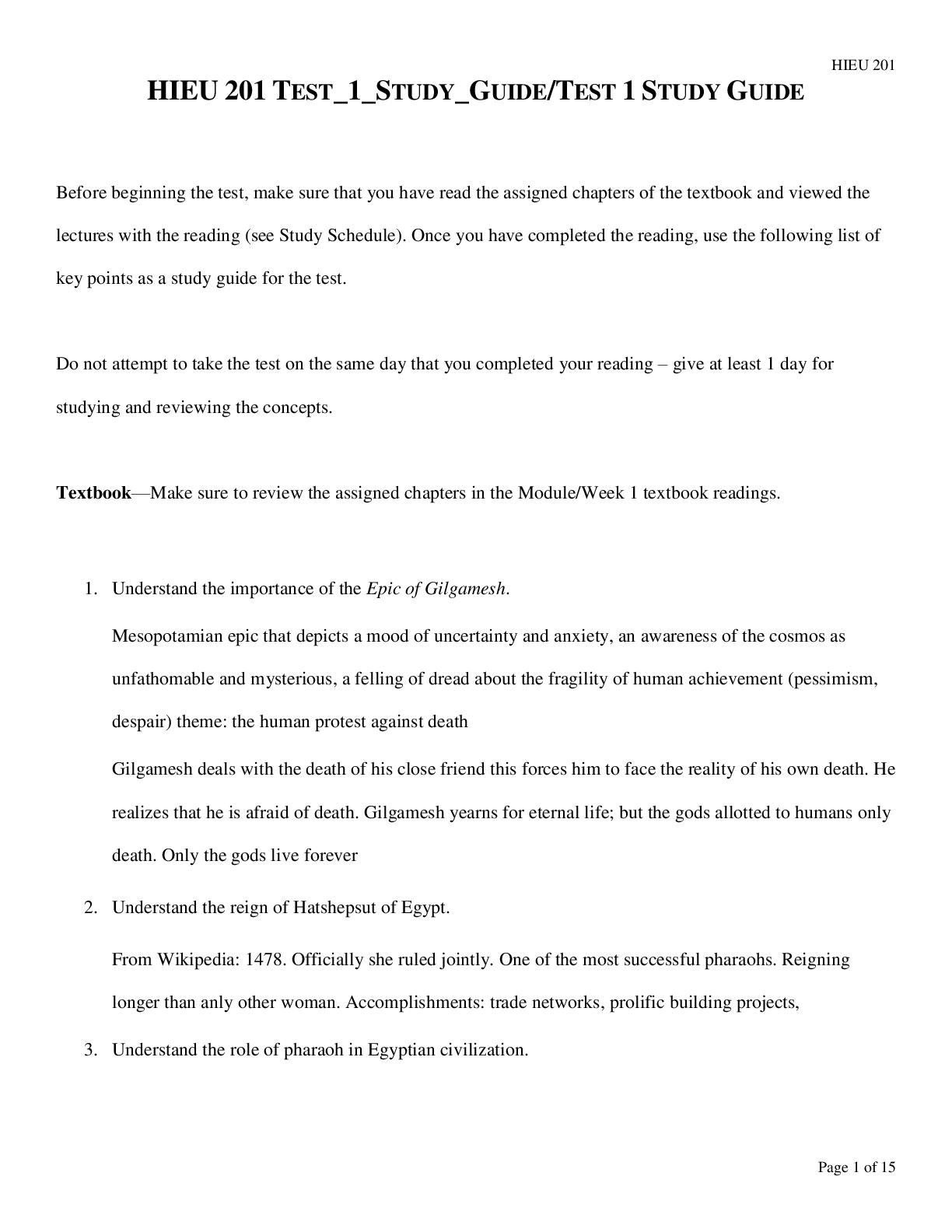
Buy this document to get the full access instantly
Instant Download Access after purchase
Buy NowInstant download
We Accept:

Reviews( 0 )
$5.50
Can't find what you want? Try our AI powered Search
Document information
Connected school, study & course
About the document
Uploaded On
Mar 16, 2021
Number of pages
15
Written in
All
Additional information
This document has been written for:
Uploaded
Mar 16, 2021
Downloads
0
Views
156


